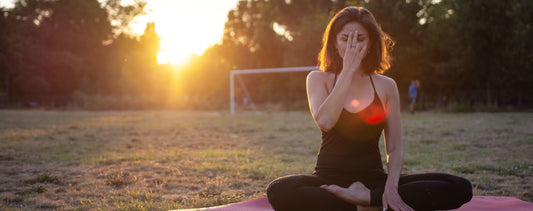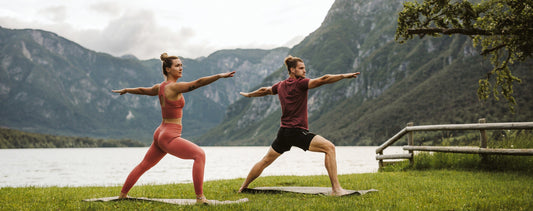It can be tempting to curl up on couch after a large, decadent holiday meal. However, doing mindful movement after you eat sets up your body to move food along and keep you comfortable. Try these six yoga poses to help stimulate digestion and detoxification.
How to do them: There are many yoga poses that are considered twists. Below are examples of a seated and supine variation.
ardha-matysendrasana.jpg
Ardha Matysendrasana (Half Lord of the Fishes Pose): Sit comfortably with your legs extended straight in front of you. Bend your right knee into your chest and place your right foot on the outer edge of your left thigh. Wrap your left arm around your right knee as you slowly begin to open your torso toward your right. Place your right hand at the base of your spine with your fingers facing the back of your mat. The twist should occur within your thoracic spine, which is the upper area of your spine. Ensure you draw your right shoulder blade down your back as you slowly twist your torso. Eventually, gently gaze over your right shoulder. While in this twist, press your sit bones into the ground and draw the crown of your head to the sky. Repeat on the left side.
supta-matsyendrasana.jpg
Supta Matsyendrasana (Supine Spinal Twist): Lie down on your back with your legs extended straight. Open your arms perpendicular to your body so your body makes an uppercase “T.” Draw your right knee into your chest; then gently draw your right knee over your body and release it down on the left side of your body. Gently turn your head to the right. Ensure both shoulders stay rooted to the ground. Hold for a few deep breaths. Repeat on the left side.
uttanasana-1.jpg
Why Uttanasana? Uttanasana is one of the most therapeutic yoga poses for the body. This pose boasts a full list of benefits, one of the main ones being that this pose helps to improve digestion. This deep forward fold is a great pose to compress the abdominal area while stimulating circulation to your digestive organs. Uttanasana is also calming to your nervous system and provides your upper body an opportunity to fully relax.
How to do it: Start standing with your feet about hips distance apart and both feet firmly pressing into the ground. Ensure your weight is distributed evenly between both feet. Inhale your arms to the sky and slowly exhale as you forward fold. You can rest your hands on the floor if they can reach comfortably. You can also reach for the backs of your thighs or for opposite elbows with your hands. Release all tension in your neck and allow your head, neck, and upper torso to completely relax. Close your eyes and hold for a few deep breaths. Place your hands on your hips and slowly inhale as you rise to a standing position while engaging your abdominals as you rise.
marjariasana.jpg Why Marjariasana and Bitilasana? By doing Marjariasana and Bitilasana, or Cat/Cow Pose, you are stretching and contracting the abdominal organs and encouraging movement in your digestive system while creating space in your abdomen.
How to do it: Come to your hands and knees. To ensure proper alignment, place your hands directly underneath your shoulders and your knees directly underneath your hips. Your toes can either be tucked under or the tops of your feet may rest on the ground. As you inhale, release your naval toward the ground and begin to arch your spine.bitilasana-0.jpg Draw your chest toward the sky and gaze up if it’s comfortable for your neck. This pose is known as Cow Pose. As you exhale, draw your naval deep into your spine and begin to round your back. Draw your chin toward your chest as you press down on the mat with your hands. This pose is known as Cat Pose. Continue to transition between Cat and Cow, moving with deep inhales and exhales. Once you’ve completed a few rounds of Cat/Cow, walk your knees a few inches further away from each other and sit back over your heals into Child’s Pose to rest for a few breaths.
pavanamuktasana.jpg
Why Pavanamuktasana? This pose is one of the best poses for digestion and to alleviate post-feast bloating. The pressure of drawing your leg against your belly will gently massage your digestive organs and encourage trapped wind to move through your digestive tract. This poses compresses and massages your ascending and descending colon, and encourages blood flow to your digestive organs.
How to do it: Lie down flat on your back with both legs extended. Draw your right knee into your chest and wrap both hands around the upper area of your right shin. Draw the knee toward the chest, which will cause your thigh to gently press against your stomach. Take about 5 to 10 deep breaths. Release your right leg and extend it down onto your mat. Repeat on the left side.
supta-baddha-konasana-0.jpg
Why Supta Baddha Konasana? This pose is the perfect way to end your post-feast yoga sequence. Supta Baddha Konasana has many restorative benefits. Notably, this pose allows your body to extend, which creates space in your torso and pelvis, and increases blood flow and stimulates your digestive organs. This pose also allows your muscles to relax.
How to do it: Lie on your back and bend your knees. Relax your knees out to the sides and place the outer edges of your feet on the ground. The heels and soles of the feet will touch one another. Gently allow your hips to open. Rest your hands down on the ground on either side of your bent legs with your palms facing up. Close your eyes and take at least 10 deep breaths. Release any tension or tightness in your body allowing your body to completely relax into the pose. To exit the pose, take hold of the backs of your thighs as you gently guide your knees in to touch one another. Give your knees a hug with your arms wrapped around your legs. Hold for a few breaths and then gently roll over to one side. Use your hands to press into the ground and come up to a comfortable seat.
Twists
Why Twists? Twists are great nourishing and detoxifying poses to help aid digestion. Twists help massage abdominal organs and stimulate Agni, or digestive fire. Your body’s Agni allows you to digest food efficiently, and absorb essential nutrients from your food, according to Ayurveda. By gently twisting your body after a large meal, you encourage fresh blood to flow to your digestive organs. Twists can feel slightly uncomfortable right after eating, so be sure to twist slowly and gently.How to do them: There are many yoga poses that are considered twists. Below are examples of a seated and supine variation.
Ardha Matysendrasana (Half Lord of the Fishes Pose): Sit comfortably with your legs extended straight in front of you. Bend your right knee into your chest and place your right foot on the outer edge of your left thigh. Wrap your left arm around your right knee as you slowly begin to open your torso toward your right. Place your right hand at the base of your spine with your fingers facing the back of your mat. The twist should occur within your thoracic spine, which is the upper area of your spine. Ensure you draw your right shoulder blade down your back as you slowly twist your torso. Eventually, gently gaze over your right shoulder. While in this twist, press your sit bones into the ground and draw the crown of your head to the sky. Repeat on the left side.
Supta Matsyendrasana (Supine Spinal Twist): Lie down on your back with your legs extended straight. Open your arms perpendicular to your body so your body makes an uppercase “T.” Draw your right knee into your chest; then gently draw your right knee over your body and release it down on the left side of your body. Gently turn your head to the right. Ensure both shoulders stay rooted to the ground. Hold for a few deep breaths. Repeat on the left side.
Uttanasana – Standing Forward Fold
Why Uttanasana? Uttanasana is one of the most therapeutic yoga poses for the body. This pose boasts a full list of benefits, one of the main ones being that this pose helps to improve digestion. This deep forward fold is a great pose to compress the abdominal area while stimulating circulation to your digestive organs. Uttanasana is also calming to your nervous system and provides your upper body an opportunity to fully relax.
How to do it: Start standing with your feet about hips distance apart and both feet firmly pressing into the ground. Ensure your weight is distributed evenly between both feet. Inhale your arms to the sky and slowly exhale as you forward fold. You can rest your hands on the floor if they can reach comfortably. You can also reach for the backs of your thighs or for opposite elbows with your hands. Release all tension in your neck and allow your head, neck, and upper torso to completely relax. Close your eyes and hold for a few deep breaths. Place your hands on your hips and slowly inhale as you rise to a standing position while engaging your abdominals as you rise.
Marjariasana and Bitilasana – Cat/Cow Pose
How to do it: Come to your hands and knees. To ensure proper alignment, place your hands directly underneath your shoulders and your knees directly underneath your hips. Your toes can either be tucked under or the tops of your feet may rest on the ground. As you inhale, release your naval toward the ground and begin to arch your spine.
Pavanamuktasana – Wind Removing Pose
Why Pavanamuktasana? This pose is one of the best poses for digestion and to alleviate post-feast bloating. The pressure of drawing your leg against your belly will gently massage your digestive organs and encourage trapped wind to move through your digestive tract. This poses compresses and massages your ascending and descending colon, and encourages blood flow to your digestive organs.
How to do it: Lie down flat on your back with both legs extended. Draw your right knee into your chest and wrap both hands around the upper area of your right shin. Draw the knee toward the chest, which will cause your thigh to gently press against your stomach. Take about 5 to 10 deep breaths. Release your right leg and extend it down onto your mat. Repeat on the left side.
Supta Baddha Konasana – Reclining Bound Angle Pose
Why Supta Baddha Konasana? This pose is the perfect way to end your post-feast yoga sequence. Supta Baddha Konasana has many restorative benefits. Notably, this pose allows your body to extend, which creates space in your torso and pelvis, and increases blood flow and stimulates your digestive organs. This pose also allows your muscles to relax.
How to do it: Lie on your back and bend your knees. Relax your knees out to the sides and place the outer edges of your feet on the ground. The heels and soles of the feet will touch one another. Gently allow your hips to open. Rest your hands down on the ground on either side of your bent legs with your palms facing up. Close your eyes and take at least 10 deep breaths. Release any tension or tightness in your body allowing your body to completely relax into the pose. To exit the pose, take hold of the backs of your thighs as you gently guide your knees in to touch one another. Give your knees a hug with your arms wrapped around your legs. Hold for a few breaths and then gently roll over to one side. Use your hands to press into the ground and come up to a comfortable seat.






















